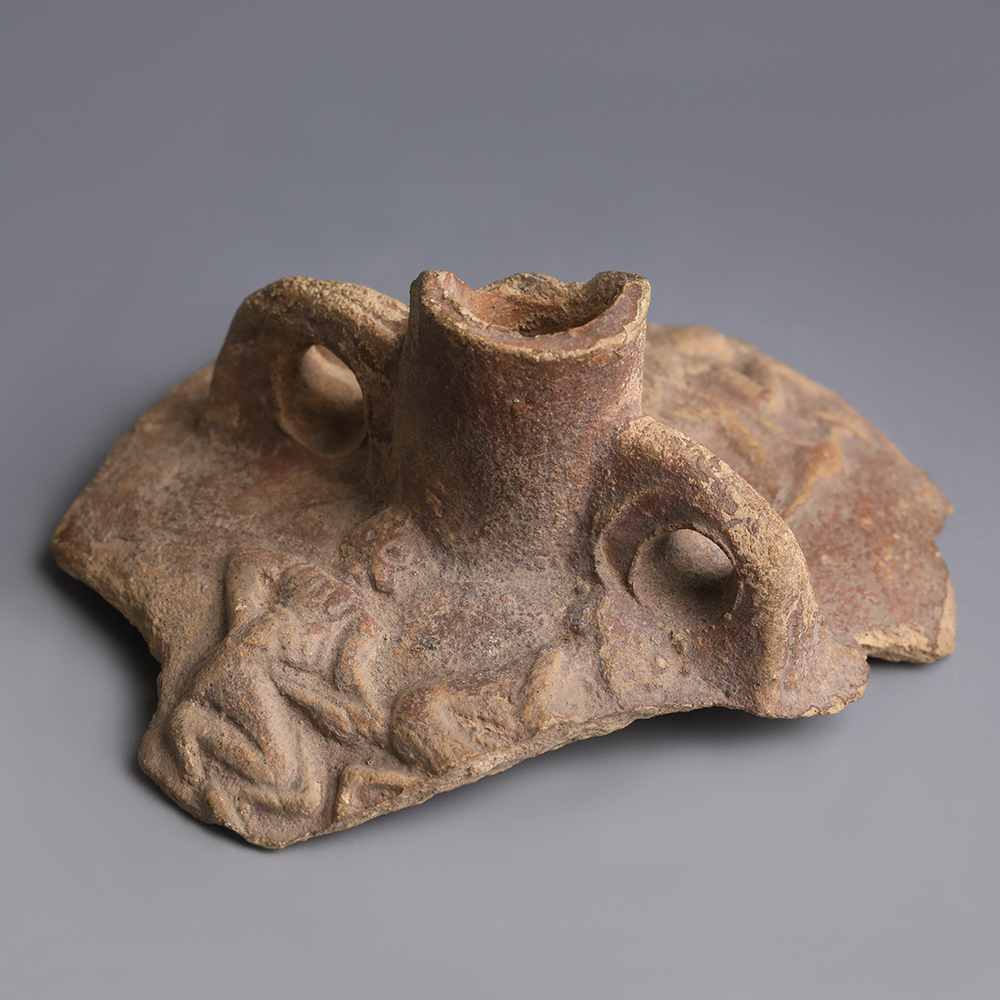Roman Terracotta Jar Fragment with Erotic Scenes
A Roman terracotta jar fragment featuring wide shoulders leading to a small cylindrical neck with a chipped rim. Two pierced handles are displayed on either side of the neck. The fragment is decorated in high relief with two erotic scenes. The first displaying a nude female pleasuring herself with several different objects. The figure has her legs bent at the knees and splayed out with both of her arms outstretched. The second scene features a copulating couple. One figure is crouched over while being penetrated from the rear by a crouching nude male, some of the scene is now missing. The reverse is unadorned.
Large Fragment of an Ur-III Clay Cuneiform Tablet
A large fragment of an Ur-III clay cuneiform tablet featuring scriptures on both the obverse and reverse. This square tablet exhibits a classic Ur-III style with the incised characters neatly displayed in rows. Some parts of the cuneiform script is now missing from over time.
Framed Fragment of a Gold Greek Diadem
A beautiful simple Ancient Greek gold diadem fragment, hammered from thin gold sheet. The piece resembles the shape of a laurel leaf, comprised of three curved lanceolate blades arching away from a single pointed tip. Each blade features a single line down the centre rendered in repoussé technique, while the rest of the leaf’s surface has been left untouched by the craftsman.
The fragment is mounted in a custom-made frame.
The leaf roughly measures 4.0cm
Bucchero-Ware Fragment of a Horse Shaped Handle
A fragment of a handle made from Bucchero ware pottery. This is a type of ceramic ware produced between the 7th and 5th centuries BC, by the Etruscans, who were pre-Romans inhabiting the Italian peninsula. The handle is decorated with a horse protome including part of the anatomical features, which have been rendered in a naturalistic style: the mane, eyes and ears are all clearly distinguishable, thanks to raised ridges. To the back, is the curved handle projecting away from the horse profile.
Romano-Egyptian Votive Terracotta Fragment of Minerva
A Romano-Egyptian terracotta fragment portraying the head of the Roman goddess Minerva. The deity is seen wearing her characteristic attribute, a large Corinthian helmet, which sits high on her head. Her hair, neatly drawn back, reveal her naturalistically executed facial features, now slightly worn due to age. This head fragment would have originally belonged to a votive statuette produced in Alexandrian workshops, exported in the Mediterranean regions. Mould-made in two sections, the fragment displays on its sides the lines where the two halves were attached together in antiquity.
Large Ammonite Fragment
A section of a very large Ammonite, displaying the classic spiral shell, formed as the ammonite grows. The fossil is around 195 million years old, and was found in Lyme Regis, Dorset. The Ammonite has been cut into a fragment, though it remains in very good condition, save some minor chips and wear to the fossil’s surface.
Old Babylonian Bull Head Alabaster Fragment
An alabaster Babylonian fragment, realistically sculpted into the shape of a bull’s head. The piece features a triangular-shaped outline that expresses the stylised anatomical details of a bull. Its facial features are clearly engraved, including two perforated eyes, in which ornamenting inlays of precious stone might have been intended, incised nostrils, incised ears and a lightly grooved mouth. This item has been hollowed, suggesting it might have been used to connect to a once complete container, probably a bull-headed, votive vessel.
Bivalve and Ammonite Fossil Fragment
A well preserved fossil fragment, featuring a closed bivalve and spiral ammonite. The Bivalve is preserved very well, and is an example of the Cardinia Listeri species – which is often found in England. The Ammonite is reasonably well preserved – there are some chips to its surface, but revealing beautiful crystalline formations.
Roman Marble Relief Fragment of Horse and Rider
A fine Ancient Roman marble fragment, possibly part of a votive figural panel carved in relief. The piece depicts a young horseman riding left and holding the bridle of a large horse. The young man wears a short, sleeved chiton (χιτών -khiton), a type of tunic fastened at the shoulders worn in Ancient Greece and Rome. The garment leaves the rider’s leg bare, revealing his long limb bent at the knee. His hair is short and his beardless face shows stylised features, giving bulging eyebrows, emphasised eyes and a snub nose to the character.
L4-6 Chondrite Meteorite Fragment
A large and well-preserved rounded chondrite meteorite fragment. This chondrite was found in Northwest Africa, and falls within the L4-6 type. L type chondrites are the second most common group of meteorites. L chondrites get their name from the low levels of iron found in the meteorite, in comparison to H chondrites, which have a high level.
By continuing to use the site, you agree to the use of cookies. more information
The cookie settings on this website are set to "allow cookies" to give you the best browsing experience possible. If you continue to use this website without changing your cookie settings or you click "Accept" below then you are consenting to this.









